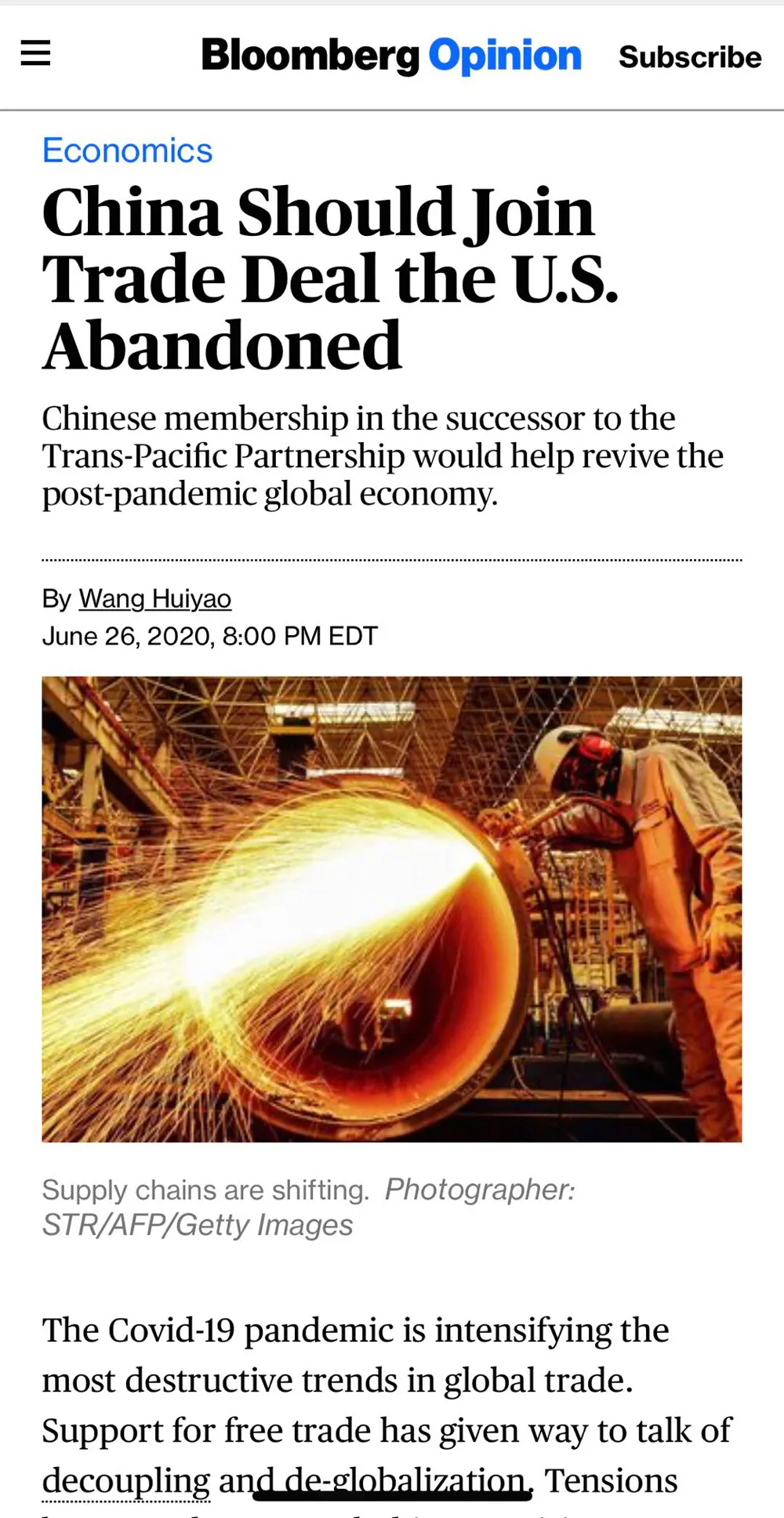Wang Huiyao: China Should Join Trade Deal the U.S. Abandoned
June 26 , 2020By Wang Huiyao | President of
the Center for China and Globalization(CCG)
From Bloomberg Opinion
The Covid-19 pandemic is intensifying the most destructive trends in global trade. Support for free trade has given way to talk of decoupling and de-globalization. Tensions between the U.S. and China are rising, as are calls for protectionism and re-shoring of far-flung supply chains. It is no longer seen as desirable, or even possible, to integrate countries that possess different economic systems or ideologies.
Reversing these trends will require dramatic action. One decision could make a real difference — for China to join the grand Pacific trade agreement the U.S. led and then abandoned.
Eighteen months ago, the Comprehensive and Progressive Trans-Pacific Partnership — heir to the more concisely named TPP — came into effect. Billed as a “next-generation” trade agreement for its high-standards and focus on emerging sectors, the pact covers 11 nations, nearly 500 million people and more than $13 trillion of GDP.
The agreement is notable for accommodating very different economies and political systems. Its members include industrialized Western democracies such as Canada and Australia, emerging markets in Latin America and Asia, and the socialist state of Vietnam.
At a time of unprecedented challenges to global trade, the CPTPP’s deep, interlocking commitments offer a way to boost growth and reduce uncertainty. Several countries have shown interest in joining. Thailand has set up a committee to decide whether to seek membership. The U.K. is soon to launch bilateral trade negotiations with Japan, which Prime Minister Boris Johnson’s government sees as a stepping stone to joining CPTPP.
At the end of May, even Chinese Premier Li Keqiang suggested that China might join the CPTPP. The idea is gaining traction in Chinese policymaking circles.
There are two obvious stumbling blocks to Chinese membership. First, China’s economic system doesn’t yet meet the standards for membership. Rules on subsidies for state-owned enterprises and restrictions on cross-border data transfers, for instance, still need to be upgraded.
Yet, domestic reforms and the “phase one” trade deal with the U.S. are beginning to close this gap. Over the past three years, efforts to improve the environment for foreign investment have accelerated. These include a new Foreign Investment Law, market opening in financial services and manufacturing, and stronger intellectual-property protections.
More such reforms can be expected. The Chinese government recently pledged to shrink the negative list of sectors closed off to foreign investment even further and to dismantle informal barriers to such investment. On June 2, a new plan was published to build Asia’s largest free-trade port on the island of Hainan, which will serve as a testbed for deeper liberalization. This follows the release of a sweeping new economic blueprint for broad pro-market measures and reform of state-owned enterprises.
Of course, these words need to be translated into action. But the other CPTPP nations can obviously judge China’s record before allowing it to join.
More problematic may be the pact’s origins. At least some of its American authors clearly saw the agreement as a means of binding the U.S. closer to Pacific economies and weaning them away from China.
With the U.S. pullout, however, such considerations have been muted. Most current members appear open to the idea of including China. Beijing’s warming ties with Tokyo are also a promising sign, as Japan is a driving force in CPTPP as well as a close ally of the U.S.
American officials might still oppose Chinese membership, of course. But they should consider this: CPTPP rules would incentivize China to make many of the structural reforms that U.S. officials have been demanding, such as subjecting state-owned companies to market discipline and improving intellectual-property protections. Accession would boost economic reformers within China, who can argue that the changes demanded by the pact align with national development objectives — from innovation and efficiency to environmental protection.
Having China in CPTPP would benefit members and the wider global economy. It would add the huge consumer market that was lost when the U.S. pulled out. With China, CPTPP would cover over 28% of global GDP. That would more than quadruple worldwide gains from CPTPP to $632 billion, according to projections by the Peterson Institute for International Economics. Chinese membership would also bring more of the regional economy under a formalized set of rules driven by multilateral consensus, supporting growth and stability.
For China, the benefits should be equally obvious. Accession would give Chinese companies greater access to a vast, dynamic market. In particular, CPTPP would help Chinese technology firms “go global,” given its emphasis on services and e-commerce.
Joining would also bolster China’s role at the heart of Asia at a time when the region’s economic landscape is shifting. Supply chains are being restructured as companies and governments seek to diversify production. This process will unfold more favorably for China if it is part of CPTPP, since moving components between China and other member states will become cheaper and more stable. Membership would give Beijing greater say in shaping future trade rules and show the nation’s commitment to free trade and integration.
In the long-term, an enlarged CPTPP could provide a blueprint for reforming the World Trade Organization and getting the global free-trade agenda back on track. Democratic nominee Joe Biden is open to rejoining the pact, so there is even a chance that China and the U.S. could one day come under CPTPP’s common umbrella. And, regardless of what the next U.S. administration decides, Chinese membership could help reduce frictions by aligning China closer with progressive global trade norms.
In the wake of Covid-19, we face the worst global recession of our lifetimes. Free trade can aid the post-pandemic recovery. If there were ever a time to consider an idea as improbable as China joining CPTPP, this is it.
From Bloomberg, 2020-6-26

Topical News See more






